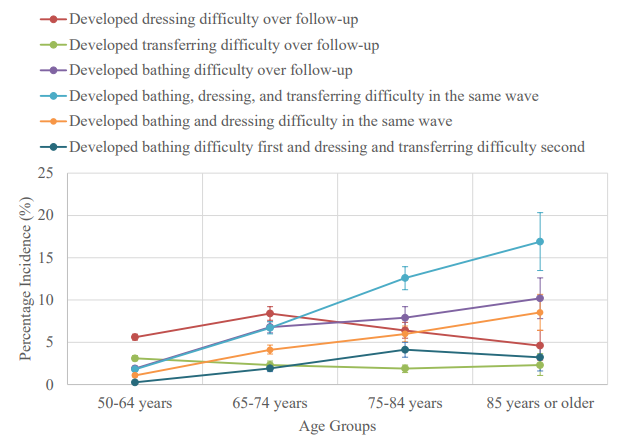
Toward a More Humane and Economically Viable Long-Term Care System
A Penn LDI Virtual Panel Looks Ahead at New Possibilities
Improving Care for Older Adults
Blog Post
Produced in conjunction with the Population Aging Research Center at the University of Pennsylvania.
Many of us think of functional impairment—having difficulty performing basic daily activities like bathing, dressing, and transferring—as a problem that affects mainly older adults, and especially the oldest old. However, the number of middle-aged adults (ages 45-64) who have functional impairment is increasing, from 13% to 16% over the last decade. Bringing a life-course perspective to this issue can help us understand why it is happening and the implications for the health and well-being of this growing population.
Why is this happening? A growing body of research suggests it is part of a larger trend of worsening health status in middle age. A study of about 150,000 adults ages 45-65 in the National Health and Interview Study shows that functional status worsened in this age group from 2002 to 2016. Unfavorable trends in income and psychological distress were associated with worsening function over time, while improving educational attainment and decreasing rates of smoking were protective factors. Additional study is needed to understand how worsening socioeconomic status may be driving these changes, potentially through exposures in the physical and social environment and health-related behaviors.
Our findings in two recent studies are starting to get at the characteristics and implications of functional impairment that develops in middle age. In the first study, we used data from the nationally representative Health and Retirement Study to look at outcomes of developing functional impairment in middle age. Among 5,540 adults ages 50-56 who did not have difficulty performing basic activities of daily living (ADLs) at baseline, we found that nearly 20% developed ADL impairment by age 64. Individuals who developed new ADL impairment were at increased risk of hospitalization and nursing home admission; those who developed new difficulty with more cognitively complex instrumental activities of daily living (e.g., managing medications, shopping) were at increased risk of hospitalization, nursing home admission, and death. Many risk factors for functional impairment in middle age were similar to those in older adults, including chronic conditions like arthritis and diabetes and health-related behaviors like smoking.
While functional impairment that develops in middle age has key similarities to impairment that develops in older adults, there are also differences. In a second study, we used data from more than 30,000 participants ages 50 and older in the Health and Retirement Study to look at the order in which functional impairments develop in different age groups. From earlier research, we know that in adults ages 65 and older, bathing difficulty is usually the first ADL problem to develop, followed by dressing difficulty and walking difficulty. Other impairments come later, with difficulty feeding oneself developing last. We wanted to see if this ordering held for middle age.
In contrast to the typical order of functional impairment in older adults, we found that difficulty transferring in and out of a bed or chair and difficulty dressing developed first in middle-aged adults (50-64 years), with bathing difficulty developing later (Figure 1). These findings suggest that the process through which ADL impairments develop differ in middle age, a finding with implications for developing age-specific interventions.

Taken together, these studies should prompt us to take notice of the growing prevalence of functional impairment in middle-aged people, and to think carefully about what types of interventions we need to develop to prevent or delay these impairments. Some interventions will likely need to be at the population level, addressing the broader trends that are driving the rising prevalence of functional impairment in middle age. Others will need to be at the individual level, targeted to prevent development of the ADL impairments that most commonly develop in middle age. Ultimately, interventions to prevent functional impairment in middle age have the potential to prevent associated adverse outcome across the life course, improving health and functional status from middle age through older age.
The study, Changes in the Hierarchy of Functional Impairment From Middle Age to Older Age, was published in The Journals of Gerontology: Series A in 2021. Authors include Rebecca T. Brown, L. Grisell Diaz-Ramirez, W. John Boscardin, Anne R. Cappola, Sei J. Lee, and Michael A. Steinman.
The study, Association of Functional Impairment in Middle Age With Hospitalization, Nursing Home Admission, and Death, was published in JAMA Internal Medicine in 2019. Authors include Rebecca T. Brown, L. Grisell Diaz-Ramirez, W. John Boscardin, Sei J. Lee, Brie A. Williams, and Michael A. Steinman.



A Penn LDI Virtual Panel Looks Ahead at New Possibilities

Lessons from the Past, Imperatives for the Future

Technology Helps Older Adults Stay at Home—But May Delay Necessary Transitions to Higher Levels of Care

Her Transitional Care Model Shows How Nurse-Led Care Can Keep Older Adults Out of the Hospital and Change Care Worldwide

Direct-to-Consumer Alzheimer’s Tests Risk False Positives, Privacy Breaches, and Discrimination, LDI Fellow Warns, While Lacking Strong Accuracy and Much More

New Therapies Inspire Hope, Even as Access and Treatment Risks Continue to Challenge Patients and Providers